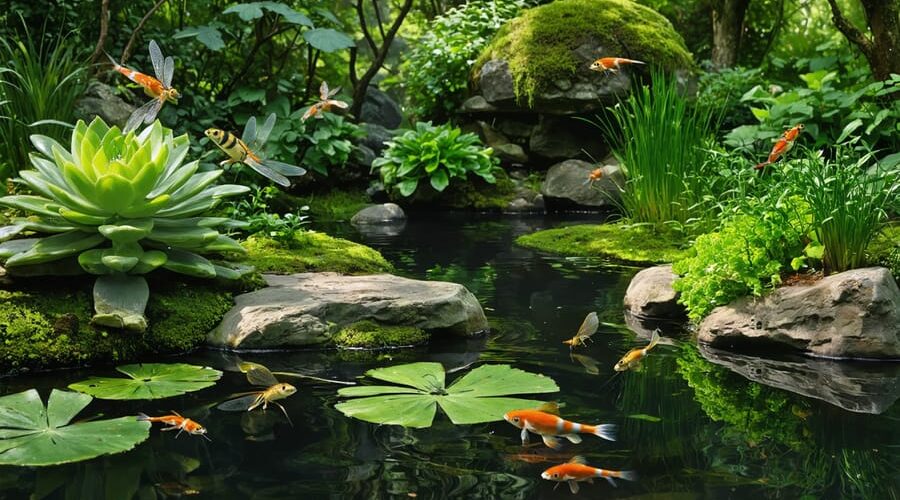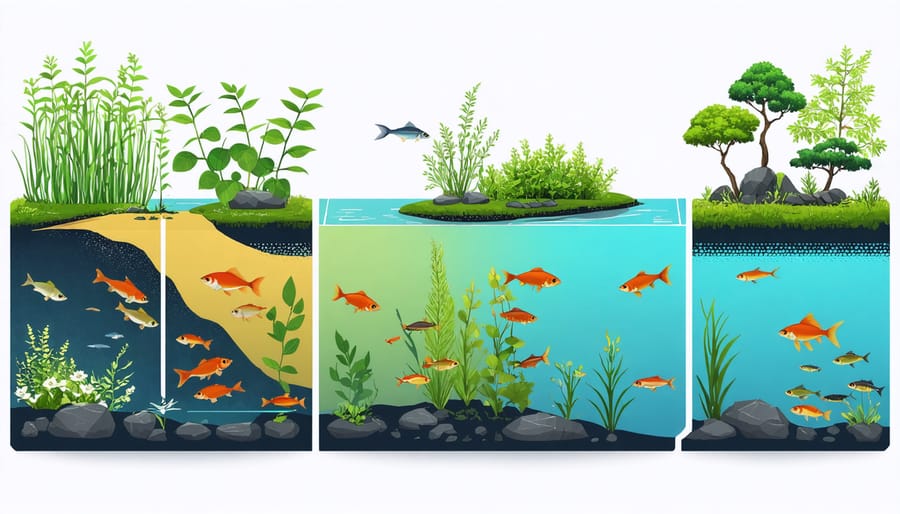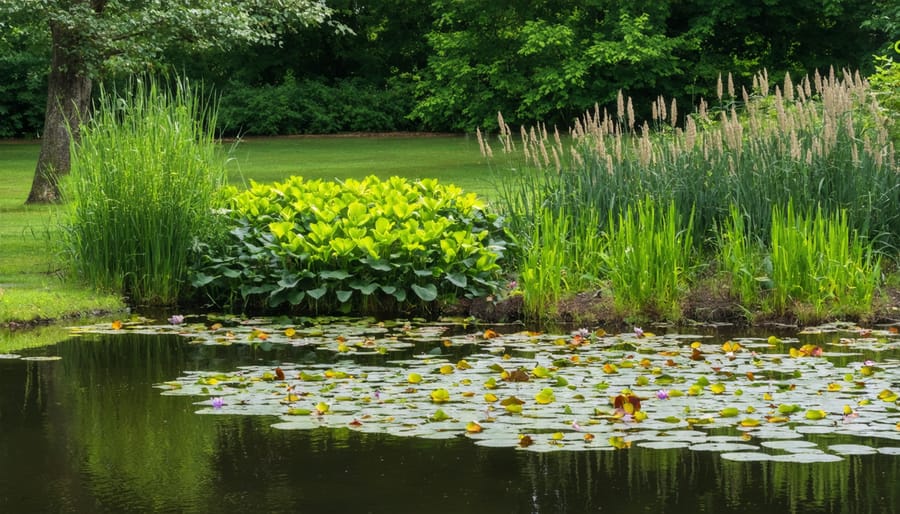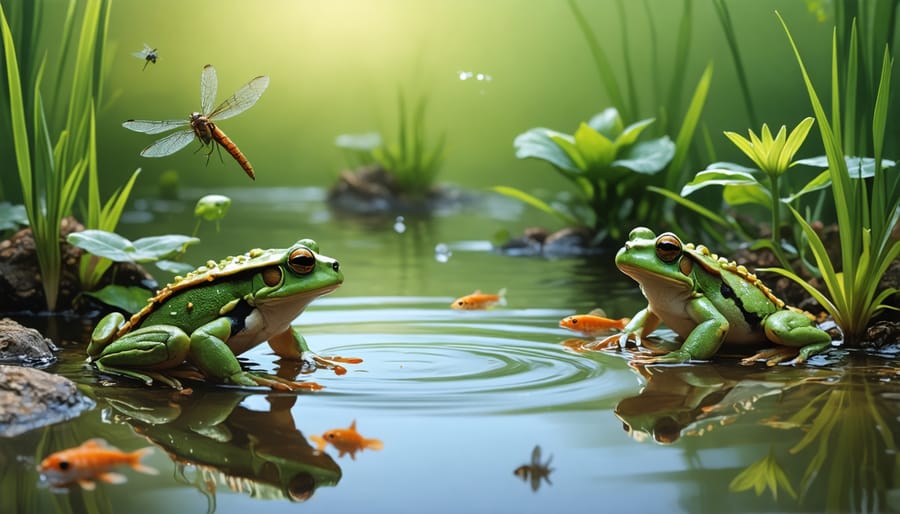
Create a Thriving Pond Paradise: How to Build Rich Biodiversity in Your Water Garden
High-biodiversity ecosystems represent nature’s most intricate and resilient living networks, where countless species interact in perfect harmony to create a thriving pond ecosystem. From the Amazon rainforest to coral reefs and wetlands, these biological hotspots showcase the remarkable complexity of life on Earth. They serve as living laboratories, teaching us invaluable lessons about ecological balance, species interdependence, and natural sustainability.
In these rich environments, every organism plays a crucial role – from microscopic bacteria breaking down organic matter to apex predators maintaining population balance. The intricate web of relationships between plants, animals, and microorganisms creates a self-sustaining system that’s remarkably resistant to environmental changes. This natural resilience makes high-biodiversity ecosystems essential for maintaining Earth’s climate stability, ensuring food security, and preserving genetic resources for future generations.
Understanding these ecosystems isn’t just about scientific curiosity – it’s about learning to create and maintain balanced environments in our own backyards, whether through wildlife-friendly gardens, natural ponds, or urban green spaces. By mimicking nature’s time-tested patterns, we can build sustainable mini-ecosystems that support local wildlife while providing beauty and environmental benefits to our communities.
The Foundation of a Biodiverse Pond
Proper Depth Zones
Creating different depth zones in your pond is crucial for supporting diverse aquatic life. Think of your pond as a multi-story apartment building, where each level serves different residents. The shallow margins (0-6 inches deep) provide essential spawning areas for fish and support marginal plants like rushes and iris. Moving deeper, the mid-depth zone (12-24 inches) is perfect for most water lilies and provides shelter for smaller fish.
The deep zone (30-36 inches or more) acts as a safe retreat for fish during extreme weather and helps maintain stable water temperatures. This area also supports submerged plants like hornwort, which oxygenate the water. For optimal biodiversity, aim to make about 30% of your pond shallow, 40% medium depth, and 30% deep water.
When creating these zones, slope the sides gradually to prevent soil erosion and make it easier for wildlife to enter and exit. Each depth zone plays a vital role in creating a thriving ecosystem, so try to include all three in your pond design, even if space is limited.

Essential Water Quality Parameters
Water quality is the foundation of a thriving ecosystem, and maintaining the right balance is crucial for supporting diverse life forms. The key parameters to monitor include pH levels, which should typically range between 6.5 and 8.5 to accommodate most aquatic species. Dissolved oxygen is equally important – aim for levels above 6 mg/L to keep fish and beneficial bacteria healthy.
Temperature stability plays a vital role, with most pond life thriving between 65-75°F (18-24°C). Sudden changes can stress inhabitants, so it’s best to make adjustments gradually. Ammonia and nitrite levels should remain as close to zero as possible, while nitrates should stay below 40 ppm to prevent algae blooms.
Water hardness and alkalinity help buffer pH changes and provide essential minerals for plant growth. A KH (carbonate hardness) between 120-180 ppm creates ideal conditions for most aquatic life. Regular testing using simple water quality kits can help you spot potential issues before they affect your pond’s biodiversity.
Remember to monitor these parameters more frequently during seasonal changes or after heavy rainfall, as these can significantly impact water quality. Clean, balanced water creates the perfect environment for a diverse ecosystem to flourish.
Creating Plant Diversity
Marginal Plants
Marginal plants play a crucial role in creating a thriving pond ecosystem, acting as a natural transition between water and land. These plants thrive in the shallow edges of your pond, typically in water depths of 0-6 inches. Popular choices include marsh marigold, iris, cattails, and rushes, each bringing unique benefits to your water garden.
When selecting marginal plants, consider varying heights and blooming seasons to create year-round interest. Tall species like purple loosestrife provide excellent backdrop coverage, while lower-growing plants like water forget-me-nots create attractive foreground displays. Place plants in groups of odd numbers for a more natural appearance, and ensure each species has enough space to spread without overwhelming its neighbors.
These plants not only add visual appeal but also provide essential shelter for wildlife, help stabilize the pond edges, and naturally filter excess nutrients from the water. For best results, plant them in specially designed marginal baskets filled with aquatic compost, and position them on shelves or secured ledges around your pond’s perimeter. Remember to trim back dead foliage in autumn to prevent excess organic matter from falling into the water.

Floating and Submerged Plants
A thriving pond ecosystem needs a careful balance of floating and submerged plants, each playing a vital role in maintaining water quality and supporting wildlife. Floating plants like water lilies and water hyacinth provide essential shade, helping regulate water temperature and preventing excessive algae growth. Their floating leaves offer perfect resting spots for dragonflies and refuge for small fish from predators.
Beneath the surface, submerged plants like hornwort and anacharis work as natural filters, absorbing excess nutrients and producing oxygen that’s crucial for fish and other aquatic life. These underwater forests create essential spawning areas for fish and safe havens for small creatures like freshwater shrimp and tadpoles.
For optimal biodiversity, aim to cover about 60% of your pond’s surface with a mix of floating plants, while submerged plants should occupy roughly 50-70% of the pond’s volume. This balance ensures enough open water for fish movement while maintaining adequate filtration and habitat space.
Remember to avoid overcrowding, as too many plants can deplete oxygen levels at night. Regular maintenance, like thinning out excessive growth during summer months, helps maintain this delicate balance and keeps your pond ecosystem healthy and vibrant.
Native Species Benefits
Native species play a crucial role in creating thriving pond ecosystems. When you choose natural pond plants that are indigenous to your area, you’re tapping into thousands of years of natural adaptation. These plants have already figured out how to thrive in your local climate and soil conditions!
Local varieties are excellent at supporting native wildlife, from beneficial insects to birds and amphibians. They’ve evolved alongside these creatures, providing just the right kind of food and shelter they need. Plus, native plants typically require less maintenance since they’re already suited to your region’s rainfall patterns and seasonal changes.
Another fantastic benefit is their natural resistance to local pests and diseases. This means you won’t need to rely heavily on chemical treatments to keep your pond healthy. Native plants also tend to grow at a more manageable rate, reducing the time you’ll spend on maintenance.
By incorporating local species, you’re not just creating a beautiful water feature – you’re helping preserve your region’s natural heritage and supporting the entire ecosystem. It’s like inviting a piece of your local wilderness right into your backyard!
Supporting Wildlife Diversity
Fish Selection and Balance
When selecting fish for your high biodiversity ecosystem, it’s crucial to choose compatible fish species that will coexist peacefully while contributing to the overall balance of your pond. Start with hardy fish like goldfish or minnows, which are excellent starter species and help maintain insect populations. Consider adding koi for their striking appearance, but remember they require more space and care.
Layer your fish population by including different species that occupy various pond depths. Surface-dwelling fish like mosquito fish help control insects, while bottom-feeders such as weather loaches keep the pond floor clean. Mid-water fish like golden orfe add movement and interest to the middle layers of your pond.
Be mindful of your pond’s size when stocking fish – a good rule of thumb is one inch of fish per square foot of surface area. Introduce fish gradually to allow the ecosystem to adjust and avoid overcrowding, which can lead to water quality issues. Mix different sizes of fish to create a natural predator-prey balance, but avoid combining aggressive species with smaller, peaceful ones.
Remember that fish contribute to the nutrient cycle by producing waste that feeds plants, while plants help filter the water for fish. This symbiotic relationship is key to maintaining a thriving ecosystem.
Attracting Beneficial Insects and Amphibians
Creating a welcoming environment for beneficial insects and amphibians is crucial for a thriving pond ecosystem. Start by incorporating diverse native plants around your pond’s edges and in shallow water areas. Plants like joe-pye weed, yarrow, and purple coneflower attract pollinators, while floating plants provide shelter for dragonflies and damselflies – natural mosquito controllers.
To attract frogs and toads, create gentle slopes and shallow areas where they can easily enter and exit the water. Include partially submerged logs or flat rocks where they can bask in the sun. Leave some taller grasses and ground cover near the pond’s edge to provide hiding spots and hunting grounds.
Beneficial insects like ladybugs and praying mantises need places to overwinter. Consider leaving some dead plant material standing during winter months and creating small brush piles nearby. Installing a “bug hotel” made from stacked wood pieces with different-sized holes can provide excellent shelter for solitary bees and other helpful insects.
Avoid using chemical pesticides around your pond, as these can harm beneficial creatures and disrupt the natural balance. Instead, let your pond’s ecosystem develop naturally – beneficial insects and amphibians will help control pest populations, while contributing to pollination and overall biodiversity.
Remember to maintain some deeper areas in your pond (at least 2 feet) to give frogs and other amphibians safe places to hibernate during winter months.

Maintaining Ecosystem Balance
Seasonal Care Strategies
Maintaining a high biodiversity ecosystem requires attention throughout the year, with each season bringing its own set of tasks and opportunities. In spring, focus on removing dead plant material and preparing your pond for new growth. This is the perfect time to divide and replant marginal plants and introduce new species to enhance biodiversity.
Summer brings abundant growth and activity. Keep an eye on water levels and top up when needed, using collected rainwater if possible. Monitor plant growth and thin out any overly aggressive species that might dominate the ecosystem. Ensure your pond has adequate shade from floating plants to prevent excessive algae growth and maintain comfortable water temperatures.
As autumn approaches, install protective netting to catch falling leaves before they sink and decay. Trim back dying foliage and remove any invasive plants that may have appeared during the growing season. This is also an excellent time to assess your pond’s overall health and plan for any changes needed next year.
Winter requires a lighter touch. Leave some plant debris for wildlife shelter and avoid breaking ice on the surface, as this can stress hibernating creatures. Instead, use a floating de-icer if necessary. Keep an eye on water quality, but avoid major maintenance tasks until spring returns.
Remember that a truly biodiverse ecosystem is resilient and largely self-maintaining, so while regular observation is important, avoid over-managing your pond. Let nature take its course while providing gentle guidance throughout the seasons.
Common Problems and Solutions
Even the most carefully planned high biodiversity ecosystems can face challenges, but most common issues have straightforward solutions. Algae blooms often occur when there’s an imbalance in nutrients, usually from overfeeding fish or insufficient plant coverage. Combat this by reducing feeding amounts and adding more floating plants to absorb excess nutrients.
Water quality problems typically arise from overcrowding or poor filtration. If you notice cloudy water or unhappy fish, consider adding more biological filtration or reducing your fish population. Regular water testing helps catch these issues early.
Predators like herons and raccoons can disturb your ecosystem’s balance. Installing protective netting or creating deeper areas where fish can hide helps maintain your pond’s biodiversity. Adding floating shelters or submerged structures provides additional safe spaces for smaller creatures.
Plant dominance can become an issue when aggressive species take over. Monitor plant growth and trim back invasive species regularly. Maintain a balance by introducing competing native plants and removing excess growth before it becomes problematic.
Disease outbreaks sometimes occur in dense populations. Prevent these by quarantining new additions before introducing them to your ecosystem and maintaining proper water conditions. If you notice signs of illness, isolate affected organisms quickly and treat appropriately.
Remember, a healthy ecosystem is self-regulating, but it needs time to establish this balance. Be patient and make gradual changes rather than dramatic interventions.
Creating a thriving, biodiverse pond ecosystem is both a rewarding journey and a valuable contribution to your local environment. Throughout this guide, we’ve explored how different elements work together to create a balanced and healthy water garden that supports a wide variety of life forms.
Remember that enhancing your pond’s biodiversity doesn’t happen overnight – it’s a gradual process that requires patience and attention. Start with the basics: ensure proper water quality, introduce a variety of native plants, and create different depth zones. As your ecosystem develops, you’ll be amazed at how naturally wildlife begins to appear and thrive in your created habitat.
Don’t be afraid to experiment with different plant combinations or habitat features, but always prioritize native species that are well-suited to your local climate. Regular maintenance and monitoring will help you spot potential issues early and keep your ecosystem in balance.
The joy of watching dragonflies dance above the water, hearing frogs chorus at dusk, and observing fish darting between water plants makes all your efforts worthwhile. Your biodiverse pond will not only enhance your garden’s beauty but also provide a crucial sanctuary for local wildlife.
Ready to start your pond biodiversity journey? Begin with small steps, learn from your experiences, and enjoy watching your water garden transform into a vibrant ecosystem that benefits both nature and your outdoor space.
